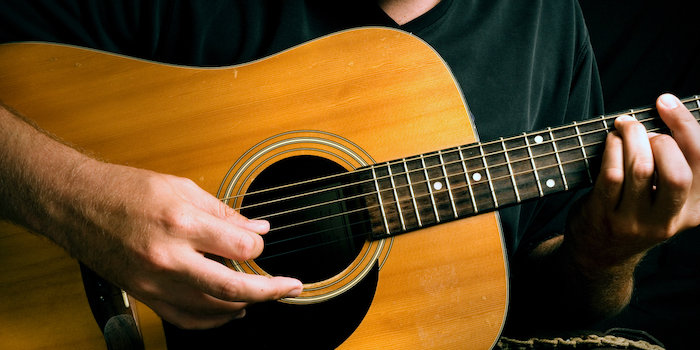Acoustic Guitar Basics

Getting a handle on some acoustic guitar basics can help you understand a few of the distinguishing features of the acoustic guitar as opposed to an electric or even classical instrument. Sure, all types of guitars have a lot in common, but they all also have those special things that make them unique (for example, you probably will never play a acoustic guitar with a whammy bar or a classical guitar with locking tuners). :)
While it may seem obvious, the main characteristic of an acoustic guitar
is that its primary sound is produced acoustically in the body of the guitar itself rather than
electrically like an electric guitar and amplifier combination.
However, it is worth noting that since the 1970s it has been possible to amplify an acoustic guitar using onboard electronics. While initial attempts were spotty at best, over time, companies such as L. R. Baggs and Fishman and newer companies such as Takamine and K&K have provided excellent ways of amplifying the onboard sound of an acoustic guitar. While it's hard to compare these systems with expensive studio mics, each year companies offer new solutions that rival studio setups (I personally have used an L. R. Baggs LB6 combined with a Dual Source Mic & Preamp with great success). Many guitars come with electronics built in, though many companies offer after market solutions (some of which are pretty easy to install). Personally, I think it's important to have the option to mic your guitar (the traditional route) as well as using onboard electronics (of course, you can also do both for the ultimate in tonal versatility).
While all types of guitars have their own unique sound and feel, there's nothing quite like the the immediacy of an acoustic guitar. When you, say, strum a chord on an acoustic guitar or fingerpick a melody, you can literally
feel the sound resonating through the body (as well as your body), which is one of the joys of
playing acoustic guitar. Unlike an electric guitar, an acoustic guitar also more portable ans self-contained - it's easy to be a one-person band with nothing but an acoustic guitar (and talent).
Still, one should note that there are a wide
range of
acoustic-electric guitars that amplify the guitar's acoustic signal, usually with microphones placed inside the guitar body, underneath the bridge, or some combination of the two.
Construction
The
acoustic guitar's construction makes its sound possible. Two of the
primary components in this construction are the guitar's top (also
called a soundboard) and its body (also called a sound box). While the
guitar's core sound is produced by the vibration of the strings, the
means to make this sound heard is needed. With an electric guitar, it's
the pickups (primarily). With an acoustic, it's the vibration of the top
coupled with the sound box.
However, the sound-box is only part of the guitar's overall construction. How to construct and affix the neck is another construction concern. Most acoustic guitars use a glued-in set neck construction, though some builders (most notably Taylor Guitars) use a type of bolt-on construction that facilitates neck resets when necessary. While initially met with skepticism, the Taylor neck system has stood the test of time and proven to be reliable and useful.
So, depending on its purpose, acoustic guitars are constructed using a wide range of body shapes, thicknesses, and construction types, all of which affect the guitar's tone.
Tone
Without getting too technical, several facets of the top/sound box affect both the volume and timbre of the acoustic guitar sound. The type of wood used has a great effect on the instrument's timbre. This perhaps applies more for acoustic and classical guitars than it does for electric guitars (there's a lot of debate in the electric guitar community about whether top or even body wood even makes a substantive difference in tone).
For example, a maple top makes the guitar sound bright and punchy whereas a cedar top has a warm and more mellow tone, so a maple top is often favorited for hard strummers while cedar is favored by fingerpickers.
The size of the sound box, as one would expect, also affects the volume.
Guitars with a large sound box (often called "jumbo" guitars) project
much more volume than a "parlor" sized guitar. Traditionally, the most popular type of acoustic guitar shape is the Dreadnought-style. However, onboard pickups
and equalization can make a small guitar sound huge simply by virtue of
external amplification.
Acoustic Guitar Basics - Questions?
In short, there are numerous types of acoustic guitars available to suit various player's needs. Hopefully, this brief discussion of the acoustic guitar was helpful. If you have any questions or would like to have a topic explored in greater detail, please let me know!
Add Your Comments Here!
I'd love for you to be a contributor to SoMuchGuitar.com!
Just fill out the information below to add to this page. I'll be in touch about your submission soon!